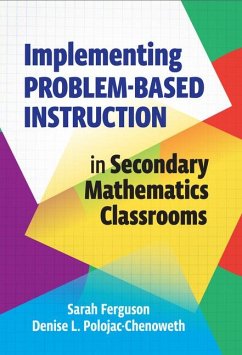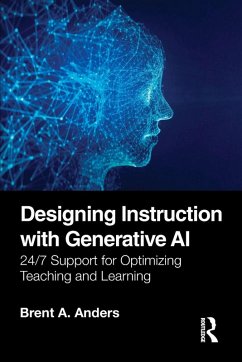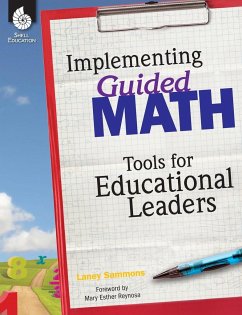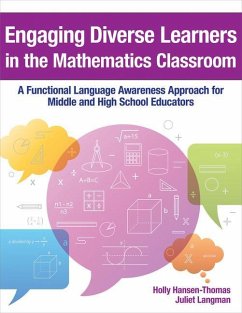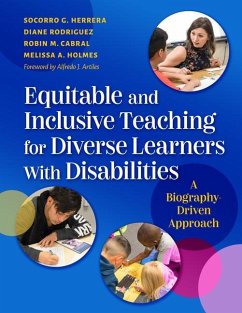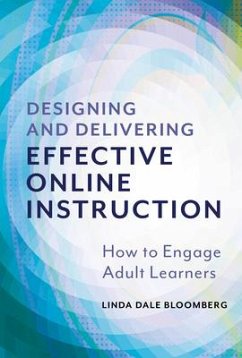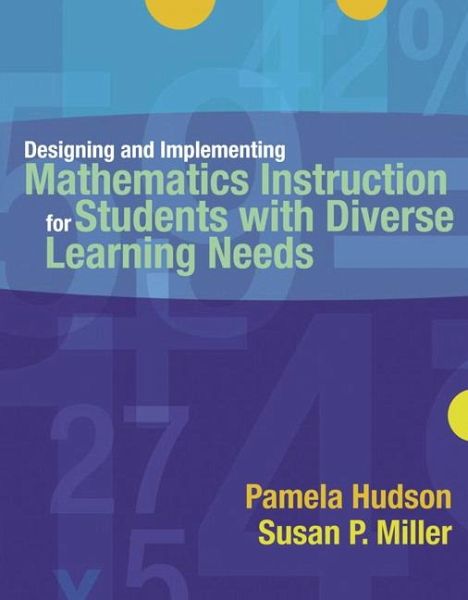
Designing and Implementing Mathematics Instruction for Students with Diverse Learning Needs
Versandkostenfrei!
Versandfertig in über 4 Wochen
126,99 €
inkl. MwSt.

PAYBACK Punkte
63 °P sammeln!
This exciting new book integrates the explicit teaching practices that have proven effective for students with disabilities with the NCTM math standards that dominant current mathematics practices in the United States.
In Part 1 of the book, teachers learn the fundamentals of mathematics assessment and instructional design for conceptual, declarative knowledge, procedural, and problem-solving lessons. In Part 2, the detailed scope and sequence charts, along with instructional guidelines keyed to the objectives, provide teachers with specific guidelines for assessment and design.
Product Description
This exciting new book integrates the explicit teaching practices that have proven effective for students with disabilities with the NCTM math standards that dominant current mathematics practices in the United States.
In Part 1 of the book, teachers learn the fundamentals of mathematics assessment and instructional design for conceptual, declarative knowledge, procedural, and problem-solving lessons. In Part 2, the detailed scope and sequence charts, along with instructional guidelines keyed to the objectives, provide teachers with specific guidelines for assessment and design.
The curriculum-based assessment chapter (Ch. 2) helps teachers group students for instruction, place in curriculum, monitor performance, and make data based decisions. Content coverage of all five NCTM content standards provides teachers the support needed to access the general education curriculum and help their students meet annual yearly progress expectations (Chapters 7 - 15). Detailed scope and sequence charts provide a valuable resource for assessing, planning,and designing instruction (Chapters 7-15). Instructional design discussion includes four domains: concepts, declarative knowledge, problem solving, and procedural knowledge. When teachers understand the function of the instruction, their effectiveness and efficiency are enhanced (Chapters 3-15). Integration of explicit teaching practices with NCTM approach helps teachers maintain practices that work for students with diverse needs while integrating reformed-based mathematics practices (in Chapters 1, 7-15). Detailed guidelines, including scripted lessons, on HOW to design and deliver effective instruction. These sample lessons illustrate how to apply the explicit teaching sequence to various content areas and provide examples for preservice and inservice teachers to use when developing their own lessons.
Features + Benefits
Curriculum-based assessment chapter (Ch. 2) helps teachers group students for instruction, place in curriculum, monitor performance, and make data based decisions.
Content coverage of all five NCTM content standards provides teachers the support needed to access the general education curriculum and help their students meet annual yearly progress expectations (Chapters 7 - 15).
Detailed scope and sequence charts provide a valuable resource for assessing, planning,and designing instruction (Chapters 7-15).
Instructional design discussion includes four domains: concepts, declarative knowledge, problem solving, and procedural knowledge. When teachers understand the function of the instruction, their effectiveness and efficiency are enhanced (Chapters 3-15).
Integration of explicit teaching practices with NCTM approach helps teachers maintain practices that work for students with diverse needs while integrating reformed-based mathematics practices (in Chapters 1, 7-15).
Detailed guidelines, including scripted lessons, on HOW to design and deliver effective instruction. These sample lessons illustrate how to apply the explicit teaching sequence to various content areas and provide examples for preservice and inservice teachers to use when developing their own lessons.
Backcover
This exciting new book integrates the explicit teaching practices that have proven effective for students with disabilities with the NCTM math standards that dominate current mathematics practices in the United States.
Highlights Include:
. Curriculum-based assessment chapter helps teachers group students for instruction, place students in the curriculum, monitor performance, and make data-based decisions. (Chapter 2)
. Content coverage of all five NCTM content standards provides teachers the support needed to access the general education curriculum and help their students meet annual yearly progress expectations (Chapters 7-15).
. Detailed scope and sequence charts provide a valuable resource for assessing, planning, and designing instruction (Chapters 7-15).
. Instructional design discussion includes four domains: concepts, declarative knowledge, problem solving, and procedural knowledge. When teachers understand the function of the instruction, their effectiveness and efficiency are enhanced (Chapters 3-15).
. Integration of explicit teaching practices with NCTM the approach helps teachers maintain practices that work for students with diverse needs while integrating reformed-based mathematics practices (Chapters 1, 7-15).
. Detailed guidelines, including scripted lessons, on how to design and deliver effective instruction. These sample lessons illustrate how to apply the explicit teaching sequence to various content areas and provide examples for pre-service and in-service teachers to use when developing their own lessons.
[MyLabSchool horizontal banner ad]
I.
1. An Overview of Mathematics Curriculum and Instruction.
A. Introduction.
B. Curriculum Factors.
1. Following a Hierarchy and Sequence of Skills.
2. Prioritizing Essential Skills.
3. Creating a Meaningful Context.
C. Instructional Domains.
1. Conceptual Understanding.
2. Declarative Knowledge.
3. Procedural Knowledge.
4. Application.
D. Explicit Teaching Cycle & Principles.
1. Curriculum-Based Assessment.
2. Planning.
3. Advance Organizer.
a. Review.
(1) Planning the review.
(2) Conducting the review.
b. State lesson objective and link.
c. Develop relevance.
4. Demonstration (I do).
a. Model thinking and action.
b. Maximize student engagement.
c. Monitor student understanding.
5. Guided Practice (We do).
a. Vary levels of support.
b. Monitoring student performance.
6. Independent Practice (You Do).
a. Planning the practice format.
b. Providing distributive practice.
c. Monitoring student performance.
7. Maintenance.
8. Monitoring Student Acquisition of New Material.
9. Teaching Culturally and Linguistically Diverse Learners.
2. Curriculum-Based Assessment and Planning.
A. Introduction.
B. Curriculum-based Assessment.
1. Types of Curriculum-based Assessments.
2. Student Performance Measures and Recording Systems.
a. Percentage.
b. Rate.
c. Error analysis.
&nbs
In Part 1 of the book, teachers learn the fundamentals of mathematics assessment and instructional design for conceptual, declarative knowledge, procedural, and problem-solving lessons. In Part 2, the detailed scope and sequence charts, along with instructional guidelines keyed to the objectives, provide teachers with specific guidelines for assessment and design.
Product Description
This exciting new book integrates the explicit teaching practices that have proven effective for students with disabilities with the NCTM math standards that dominant current mathematics practices in the United States.
In Part 1 of the book, teachers learn the fundamentals of mathematics assessment and instructional design for conceptual, declarative knowledge, procedural, and problem-solving lessons. In Part 2, the detailed scope and sequence charts, along with instructional guidelines keyed to the objectives, provide teachers with specific guidelines for assessment and design.
The curriculum-based assessment chapter (Ch. 2) helps teachers group students for instruction, place in curriculum, monitor performance, and make data based decisions. Content coverage of all five NCTM content standards provides teachers the support needed to access the general education curriculum and help their students meet annual yearly progress expectations (Chapters 7 - 15). Detailed scope and sequence charts provide a valuable resource for assessing, planning,and designing instruction (Chapters 7-15). Instructional design discussion includes four domains: concepts, declarative knowledge, problem solving, and procedural knowledge. When teachers understand the function of the instruction, their effectiveness and efficiency are enhanced (Chapters 3-15). Integration of explicit teaching practices with NCTM approach helps teachers maintain practices that work for students with diverse needs while integrating reformed-based mathematics practices (in Chapters 1, 7-15). Detailed guidelines, including scripted lessons, on HOW to design and deliver effective instruction. These sample lessons illustrate how to apply the explicit teaching sequence to various content areas and provide examples for preservice and inservice teachers to use when developing their own lessons.
Features + Benefits
Curriculum-based assessment chapter (Ch. 2) helps teachers group students for instruction, place in curriculum, monitor performance, and make data based decisions.
Content coverage of all five NCTM content standards provides teachers the support needed to access the general education curriculum and help their students meet annual yearly progress expectations (Chapters 7 - 15).
Detailed scope and sequence charts provide a valuable resource for assessing, planning,and designing instruction (Chapters 7-15).
Instructional design discussion includes four domains: concepts, declarative knowledge, problem solving, and procedural knowledge. When teachers understand the function of the instruction, their effectiveness and efficiency are enhanced (Chapters 3-15).
Integration of explicit teaching practices with NCTM approach helps teachers maintain practices that work for students with diverse needs while integrating reformed-based mathematics practices (in Chapters 1, 7-15).
Detailed guidelines, including scripted lessons, on HOW to design and deliver effective instruction. These sample lessons illustrate how to apply the explicit teaching sequence to various content areas and provide examples for preservice and inservice teachers to use when developing their own lessons.
Backcover
This exciting new book integrates the explicit teaching practices that have proven effective for students with disabilities with the NCTM math standards that dominate current mathematics practices in the United States.
Highlights Include:
. Curriculum-based assessment chapter helps teachers group students for instruction, place students in the curriculum, monitor performance, and make data-based decisions. (Chapter 2)
. Content coverage of all five NCTM content standards provides teachers the support needed to access the general education curriculum and help their students meet annual yearly progress expectations (Chapters 7-15).
. Detailed scope and sequence charts provide a valuable resource for assessing, planning, and designing instruction (Chapters 7-15).
. Instructional design discussion includes four domains: concepts, declarative knowledge, problem solving, and procedural knowledge. When teachers understand the function of the instruction, their effectiveness and efficiency are enhanced (Chapters 3-15).
. Integration of explicit teaching practices with NCTM the approach helps teachers maintain practices that work for students with diverse needs while integrating reformed-based mathematics practices (Chapters 1, 7-15).
. Detailed guidelines, including scripted lessons, on how to design and deliver effective instruction. These sample lessons illustrate how to apply the explicit teaching sequence to various content areas and provide examples for pre-service and in-service teachers to use when developing their own lessons.
[MyLabSchool horizontal banner ad]
I.
1. An Overview of Mathematics Curriculum and Instruction.
A. Introduction.
B. Curriculum Factors.
1. Following a Hierarchy and Sequence of Skills.
2. Prioritizing Essential Skills.
3. Creating a Meaningful Context.
C. Instructional Domains.
1. Conceptual Understanding.
2. Declarative Knowledge.
3. Procedural Knowledge.
4. Application.
D. Explicit Teaching Cycle & Principles.
1. Curriculum-Based Assessment.
2. Planning.
3. Advance Organizer.
a. Review.
(1) Planning the review.
(2) Conducting the review.
b. State lesson objective and link.
c. Develop relevance.
4. Demonstration (I do).
a. Model thinking and action.
b. Maximize student engagement.
c. Monitor student understanding.
5. Guided Practice (We do).
a. Vary levels of support.
b. Monitoring student performance.
6. Independent Practice (You Do).
a. Planning the practice format.
b. Providing distributive practice.
c. Monitoring student performance.
7. Maintenance.
8. Monitoring Student Acquisition of New Material.
9. Teaching Culturally and Linguistically Diverse Learners.
2. Curriculum-Based Assessment and Planning.
A. Introduction.
B. Curriculum-based Assessment.
1. Types of Curriculum-based Assessments.
2. Student Performance Measures and Recording Systems.
a. Percentage.
b. Rate.
c. Error analysis.
&nbs
This exciting new book integrates the explicit teaching practices that have proven effective for students with disabilities with the NCTM math standards that dominant current mathematics practices in the United States . In Part 1 of the book, teachers learn the fundamentals of mathematics assessment and instructional design for conceptual, declarative knowledge, procedural, and problem-solving lessons. In Part 2, the detailed scope and sequence charts, along with instructional guidelines keyed to the objectives, provide teachers with specific guidelines for assessment and design. The curriculum-based assessment chapter (Ch. 2) helps teachers group students for instruction, place in curriculum, monitor performance, and make data based decisions. Content coverage of all five NCTM content standards provides teachers the support needed to access the general education curriculum and help their students meet annual yearly progress expectations (Chapters 7 — 15). Detailed scope and sequence charts provide a valuable resource for assessing, planning,and designing instruction (Chapters 7-15). Instructional design discussion includes four domains: concepts, declarative knowledge, problem solving, and procedural knowledge. When teachers understand the function of the instruction, their effectiveness and efficiency are enhanced (Chapters 3-15). Integration of explicit teaching practices with NCTM approach helps teachers maintain practices that work for students with diverse needs while integrating reformed-based mathematics practices (in Chapters 1, 7-15). Detailed guidelines, including scripted lessons, on HOW to design and deliver effective instruction. These sample lessons illustrate how to apply the explicit teaching sequence to various content areas and provide examples for preservice and inservice teachers to use when developing their own lessons.



